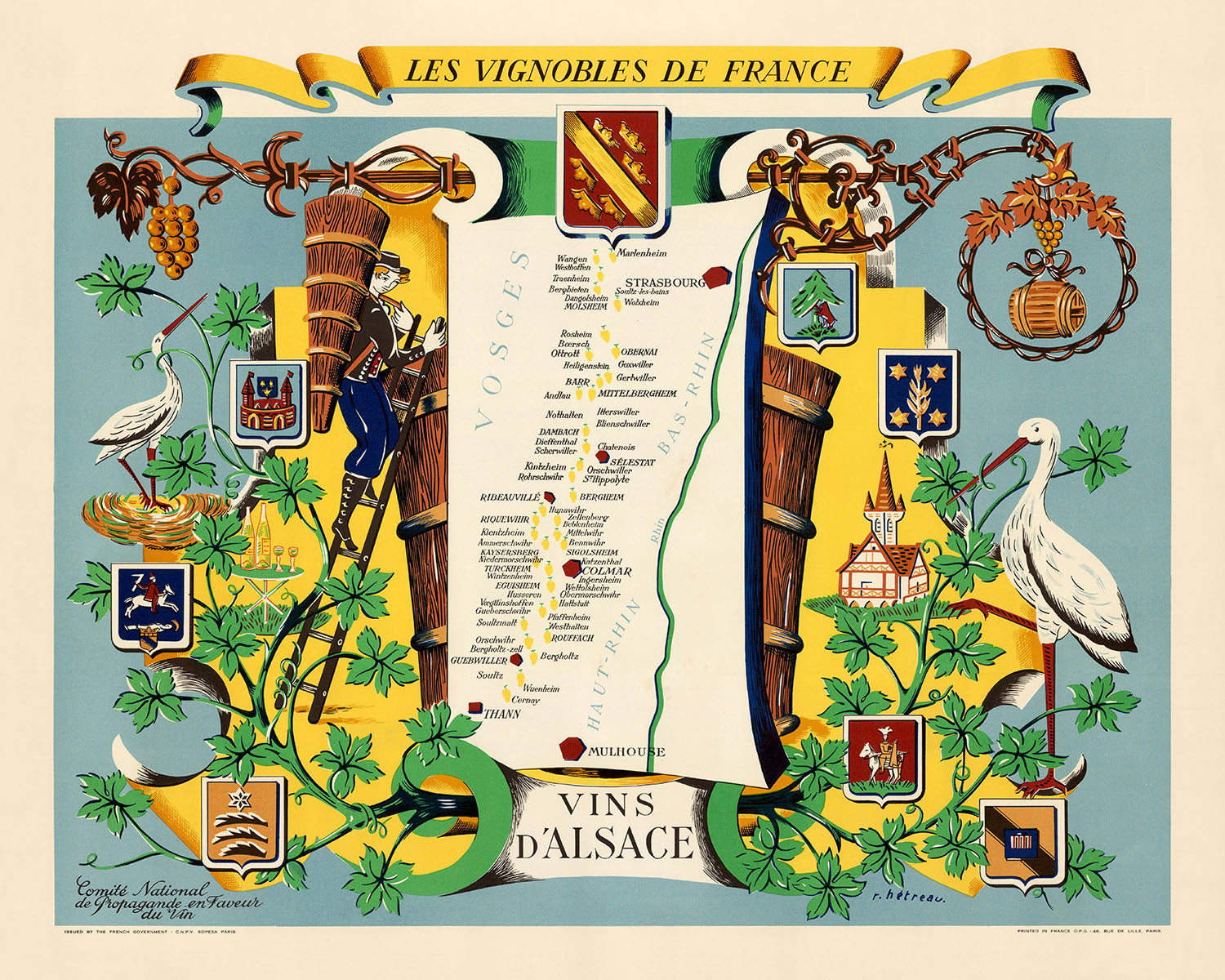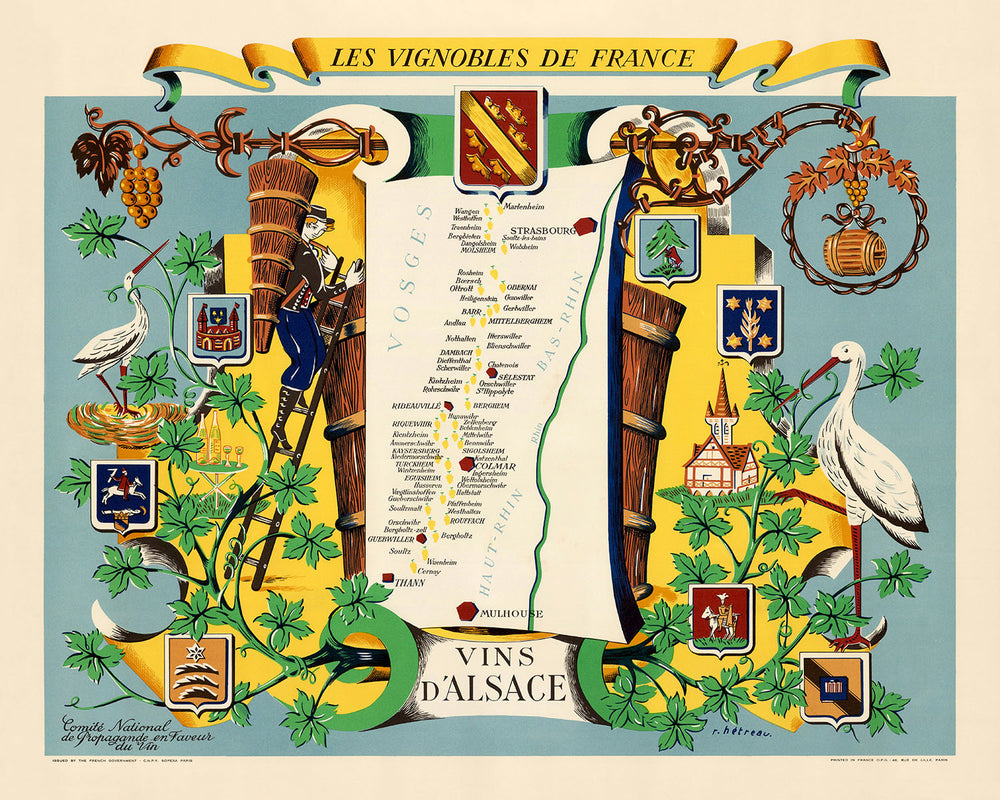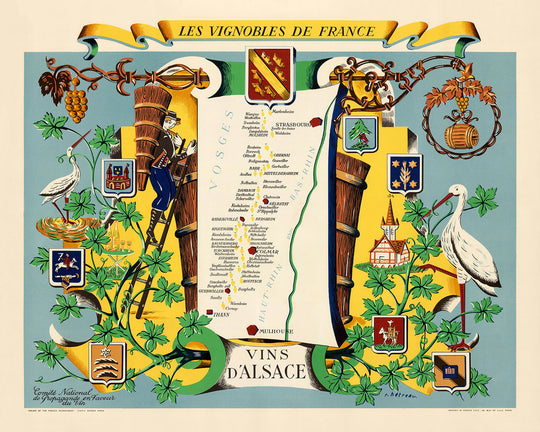- Handmade locally. No import duty or tax
- FREE Delivery by Christmas
- Love it or your money back (90 days)
- Questions? WhatsApp me any time
Own a piece of history
5,000+ 5 star reviews


"Les Vignobles De France -- Vins d'Alsace," crafted by the esteemed French artist Remy Hetreau in 1954, is a splendid example of mid-20th-century cartographic artistry. This map, part of a series commissioned by the Comité National de Propagande en Faveur du Vin, vividly illustrates the wine-producing regions of Alsace. Hetreau, renowned for his etchings and engravings, brings a unique blend of artistic finesse and detailed geographical representation to this work. The map not only serves as a promotional tool for the French wine industry but also as a captivating piece of art that reflects the rich cultural heritage of Alsace.
The map's design is both intricate and vibrant, featuring clusters of grapes in red and yellow to denote the regions producing red and white wines, respectively. Surrounding the map are decorative elements such as a compass rose, a sailing vessel, and a chateau, which add to its aesthetic appeal. Illustrations of storks, traditional Alsatian architecture, and wine-related motifs like barrels and wine glasses further enrich the visual narrative. The inclusion of coats of arms and vine leaves interwoven with the map's layout underscores the deep connection between the region's identity and its viticultural tradition.
Alsace, a region known for its picturesque landscapes and historic significance, is meticulously detailed in this map. It highlights the borders of the Vosges and Alsace regions, providing a clear geographical context. The map also features a variety of towns and cities, each a gem in the Alsatian crown, from the bustling Strasbourg to the charming Colmar. The detailed depiction of these settlements offers a glimpse into the region's diverse and rich history, making the map not just a guide for wine enthusiasts but also a historical document.
The creation of this map in the post-World War II era adds another layer of historical significance. It represents a period when France was actively promoting its cultural and economic assets to revive its industries. The Comité National de Propagande en Faveur du Vin's initiative to commission such maps was part of a broader effort to boost tourism and celebrate French craftsmanship. Hetreau's work, therefore, is not just a map but a symbol of resilience and cultural pride, encapsulating the spirit of an era.
Remy Hetreau's legacy as an artist and designer is evident in every detail of this map. Known for his work in various mediums, including murals and china designs, Hetreau's versatility and artistic vision shine through. His ability to blend artistic beauty with functional cartography makes this map a valuable addition to any collection. It stands as a testament to his skill and the enduring allure of Alsace's wine regions, inviting viewers to explore and appreciate the rich tapestry of history and culture that it represents.
Cities and towns on this map
- Strasbourg
- Mulhouse
- Colmar
- Sélestat
- Thann
- Guebwiller
- Ribeauvillé
- Rouffach
- Turckheim
- Bergheim
- Riquewihr
- Kaysersberg
- Ammerschwihr
- Eguisheim
- Niedermorschwihr
- Bennwihr
- Sigolsheim
- Hunawihr
- Mittelwihr
- Zellenberg
- Beblenheim
- Obermorschwihr
- Hattstatt
- Voegtlinshoffen
- Oberhergheim
- Herrlisheim
- Husseren-les-Châteaux
- Pfaffenheim
- Westhalten
- Soultzmatt
- Orschwihr
- Bergholtz
- Bergholtz-Zell
- Buhl
- Saint-Hippolyte
- Rodern
- Rorschwihr
- Kintzheim
- Orschwiller
- Châtenois
- Scherwiller
- Dambach-la-Ville
- Dieffenthal
- Blienschwiller
- Nothalten
- Itterswiller
- Epfig
- Mittelbergheim
- Andlau
- Barr
- Heiligenstein
- Gertwiller
- Goxwiller
- Obernai
- Niedernai
- Meistratzheim
- Krautergersheim
- Bernardswiller
- Rosheim
- Molsheim
- Avolsheim
- Dorlisheim
- Ergersheim
- Soultz-les-Bains
- Marlenheim
- Wangen
- Traenheim
- Balbronn
- Bergbieten
- Dangolsheim
- Scharrarbergheim
- Westhoffen
- Kirchheim
- Osthoffen
- Achenheim
- Wolfisheim
- Oberschaeffolsheim
- Hangenbieten
- Holtzheim
- Lingolsheim
- Illkirch-Graffenstaden
- Geispolsheim
- Fegersheim
- Eschau
- Plobsheim
- Nordhouse
- Erstein
- Duttlenheim
- Duppigheim
- Entzheim
- Innenheim
- Griesheim-près-Molsheim
- Altorf
- Kolbsheim
- Mollkirch
- Still
- Heiligenberg
- Gresswiller
- Mutzig
- Wolxheim
Notable Features & Landmarks
- Compass rose
- Clusters of grapes (red and yellow)
- Sailing vessel
- Chateau
- Illustrations of storks
- Coats of arms
- Wine barrels
- Vine leaves and vines
- Illustrations of wine glasses and bottles
- Depiction of a wine harvester
- Illustration of a church
- Illustrations of traditional Alsatian architecture
- Map legend indicating wine types
- Borders of Vosges and Alsace regions
- Illustrative typography and calligraphy
- Decorative scrolls and banners
- Illustrations of wine regions with grape clusters
- Artistic depiction of a vineyard scene
- Illustration of a traditional wine press
- Decorative elements surrounding the map
Historical and design context
- Name of the map: Les Vignobles De France -- Vins d'Alsace (The Vineyards of France -- Wines of Alsace)
- Date of creation: 1954
- Mapmaker/Publisher: Remy Hetreau
- About the mapmaker: Remy Hetreau was a French artist, printmaker, illustrator, and designer known for his etchings and engravings. He illustrated numerous books and created designs for Haviland Limoges china, painted murals, and designed international exhibitions of French technology.
- Topics and themes:
- Wine regions: The map highlights the major wine-producing regions of Alsace.
- Wine types: Red wines are indicated with red grape clusters and white wines with yellow grape clusters.
- Promotional purpose: The map was part of a series promoting French wines and tourism.
- Series: This map is one of a series of 11 maps titled Les Vignobles de France, commissioned by the Comité National de Propagande en Faveur du Vin.
- Countries and regions shown: Alsace region of France
- Design and style:
- Pictorial elements: Includes a compass rose, grapes on the vine, a sailing vessel, and a chateau.
- Artistic features: Incorporates vibrant illustrations and thematic elements related to wine and Alsace.
- Historical significance:
- Promotion of French wine industry: The map was used to advertise French wines and tourism, reflecting the cultural and economic importance of wine in France.
- Post-war France: Created in the post-World War II era, it represents efforts to revive and promote French industries.
Please double check the images to make sure that a specific town or place is shown on this map. You can also get in touch and ask us to check the map for you.
This map looks great at every size, but I always recommend going for a larger size if you have space. That way you can easily make out all of the details.
This map looks amazing at sizes all the way up to 50in (125cm). If you are looking for a larger map, please get in touch.
The model in the listing images is holding the 16x20in (40x50cm) version of this map.
The fifth listing image shows an example of my map personalisation service.
If you’re looking for something slightly different, check out my collection of the best old maps to see if something else catches your eye.
Please contact me to check if a certain location, landmark or feature is shown on this map.
This would make a wonderful birthday, Christmas, Father's Day, work leaving, anniversary or housewarming gift for someone from the areas covered by this map.
This map is available as a giclée print on acid free archival matte paper, or you can buy it framed. The frame is a nice, simple black frame that suits most aesthetics. Please get in touch if you'd like a different frame colour or material. My frames are glazed with super-clear museum-grade acrylic (perspex/acrylite), which is significantly less reflective than glass, safer, and will always arrive in perfect condition.
This map is also available as a float framed canvas, sometimes known as a shadow gap framed canvas or canvas floater. The map is printed on artist's cotton canvas and then stretched over a handmade box frame. We then "float" the canvas inside a wooden frame, which is available in a range of colours (black, dark brown, oak, antique gold and white). This is a wonderful way to present a map without glazing in front. See some examples of float framed canvas maps and explore the differences between my different finishes.
For something truly unique, this map is also available in "Unique 3D", our trademarked process that dramatically transforms the map so that it has a wonderful sense of depth. We combine the original map with detailed topography and elevation data, so that mountains and the terrain really "pop". For more info and examples of 3D maps, check my Unique 3D page.
For most orders, delivery time is about 3 working days. Personalised and customised products take longer, as I have to do the personalisation and send it to you for approval, which usually takes 1 or 2 days.
Please note that very large framed orders usually take longer to make and deliver.
If you need your order to arrive by a certain date, please contact me before you order so that we can find the best way of making sure you get your order in time.
I print and frame maps and artwork in 23 countries around the world. This means your order will be made locally, which cuts down on delivery time and ensures that it won't be damaged during delivery. You'll never pay customs or import duty, and we'll put less CO2 into the air.
All of my maps and art prints are well packaged and sent in a rugged tube if unframed, or surrounded by foam if framed.
I try to send out all orders within 1 or 2 days of receiving your order, though some products (like face masks, mugs and tote bags) can take longer to make.
If you select Express Delivery at checkout your order we will prioritise your order and send it out by 1-day courier (Fedex, DHL, UPS, Parcelforce).
Next Day delivery is also available in some countries (US, UK, Singapore, UAE) but please try to order early in the day so that we can get it sent out on time.
My standard frame is a gallery style black ash hardwood frame. It is simple and quite modern looking. My standard frame is around 20mm (0.8in) wide.
I use super-clear acrylic (perspex/acrylite) for the frame glass. It's lighter and safer than glass - and it looks better, as the reflectivity is lower.
Six standard frame colours are available for free (black, dark brown, dark grey, oak, white and antique gold). Custom framing and mounting/matting is available if you're looking for something else.
Most maps, art and illustrations are also available as a framed canvas. We use matte (not shiny) cotton canvas, stretch it over a sustainably sourced box wood frame, and then 'float' the piece within a wood frame. The end result is quite beautiful, and there's no glazing to get in the way.
All frames are provided "ready to hang", with either a string or brackets on the back. Very large frames will have heavy duty hanging plates and/or a mounting baton. If you have any questions, please get in touch.
See some examples of my framed maps and framed canvas maps.
Alternatively, I can also supply old maps and artwork on canvas, foam board, cotton rag and other materials.
If you want to frame your map or artwork yourself, please read my size guide first.
My maps are extremely high quality reproductions of original maps.
I source original, rare maps from libraries, auction houses and private collections around the world, restore them at my London workshop, and then use specialist giclée inks and printers to create beautiful maps that look even better than the original.
My maps are printed on acid-free archival matte (not glossy) paper that feels very high quality and almost like card. In technical terms the paper weight/thickness is 10mil/200gsm. It's perfect for framing.
I print with Epson ultrachrome giclée UV fade resistant pigment inks - some of the best inks you can find.
I can also make maps on canvas, cotton rag and other exotic materials.
Learn more about The Unique Maps Co.
Map personalisation
If you're looking for the perfect anniversary or housewarming gift, I can personalise your map to make it truly unique. For example, I can add a short message, or highlight an important location, or add your family's coat of arms.
The options are almost infinite. Please see my map personalisation page for some wonderful examples of what's possible.
To order a personalised map, select "personalise your map" before adding it to your basket.
Get in touch if you're looking for more complex customisations and personalisations.
Map ageing
I have been asked hundreds of times over the years by customers if they could buy a map that looks even older.
Well, now you can, by selecting Aged before you add a map to your basket.
All the product photos you see on this page show the map in its Original form. This is what the map looks like today.
If you select Aged, I will age your map by hand, using a special and unique process developed through years of studying old maps, talking to researchers to understand the chemistry of aging paper, and of course... lots of practice!
If you're unsure, stick to the Original colour of the map. If you want something a bit darker and older looking, go for Aged.
If you are not happy with your order for any reason, contact me and I'll get it fixed ASAP, free of charge. Please see my returns and refund policy for more information.
I am very confident you will like your restored map or art print. I have been doing this since 1984. I'm a 5-star Etsy seller. I have sold tens of thousands of maps and art prints and have over 5,000 real 5-star reviews. My work has been featured in interior design magazines, on the BBC, and on the walls of dozens of 5-star hotels.
I use a unique process to restore maps and artwork that is massively time consuming and labour intensive. Hunting down the original maps and illustrations can take months. I use state of the art and eye-wateringly expensive technology to scan and restore them. As a result, I guarantee my maps and art prints are a cut above the rest. I stand by my products and will always make sure you're 100% happy with what you receive.
Almost all of my maps and art prints look amazing at large sizes (200cm, 6.5ft+) and I can frame and deliver them to you as well, via special oversized courier. Contact me to discuss your specific needs.
Or try searching for something!
















































